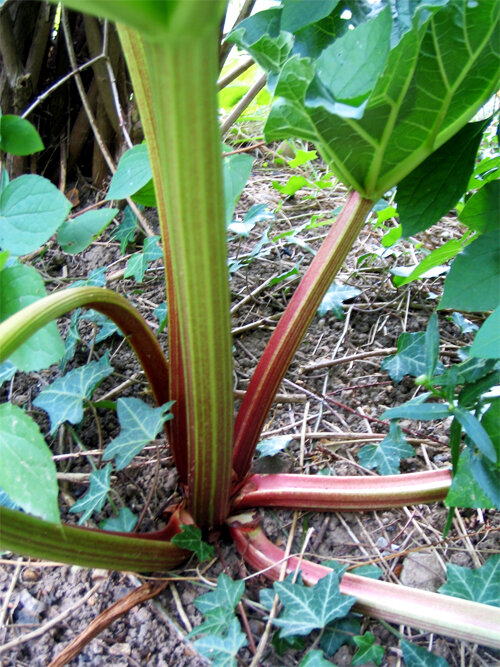Burdock: It's More Than Just Burs
Prefer to listen to this article? No problem! Four Season Foraging now offers free audio versions of articles with the help of a text-to-speech website. Simply click the play button on the right!
Many of us have encountered burdock while walking through fields or forest edges, but don’t even realize it until we’re pulling the velcro-like burs from our clothing and muttering curse words. Or if you’re like me, you might notice it before your friends and instigate a bur-throwing battle! Regardless, the bur is typically the most-recognized part. But once you start eating burdock, you might be more apt to notice the tasty parts— which, fortunately, there are several of!
Habitat and Distribution
Common burdock (Arctium minus) growing along a trail.
Introduced from Europe, burdock can be found in open fields, along trails, roadsides, and in disturbed soils. It often spreads prolifically, and is considered an invasive species in several states.
Common burdock (Arctium minus) grows in most of the US, except Florida and Hawaii. It also extends across southern Canada. Greater burdock (Arctium lappa) has a smaller range, growing in northern US states from California east to Maryland, and north across southern Canada. It is also found in Hawaii, North Carolina, and Georgia.
Identification
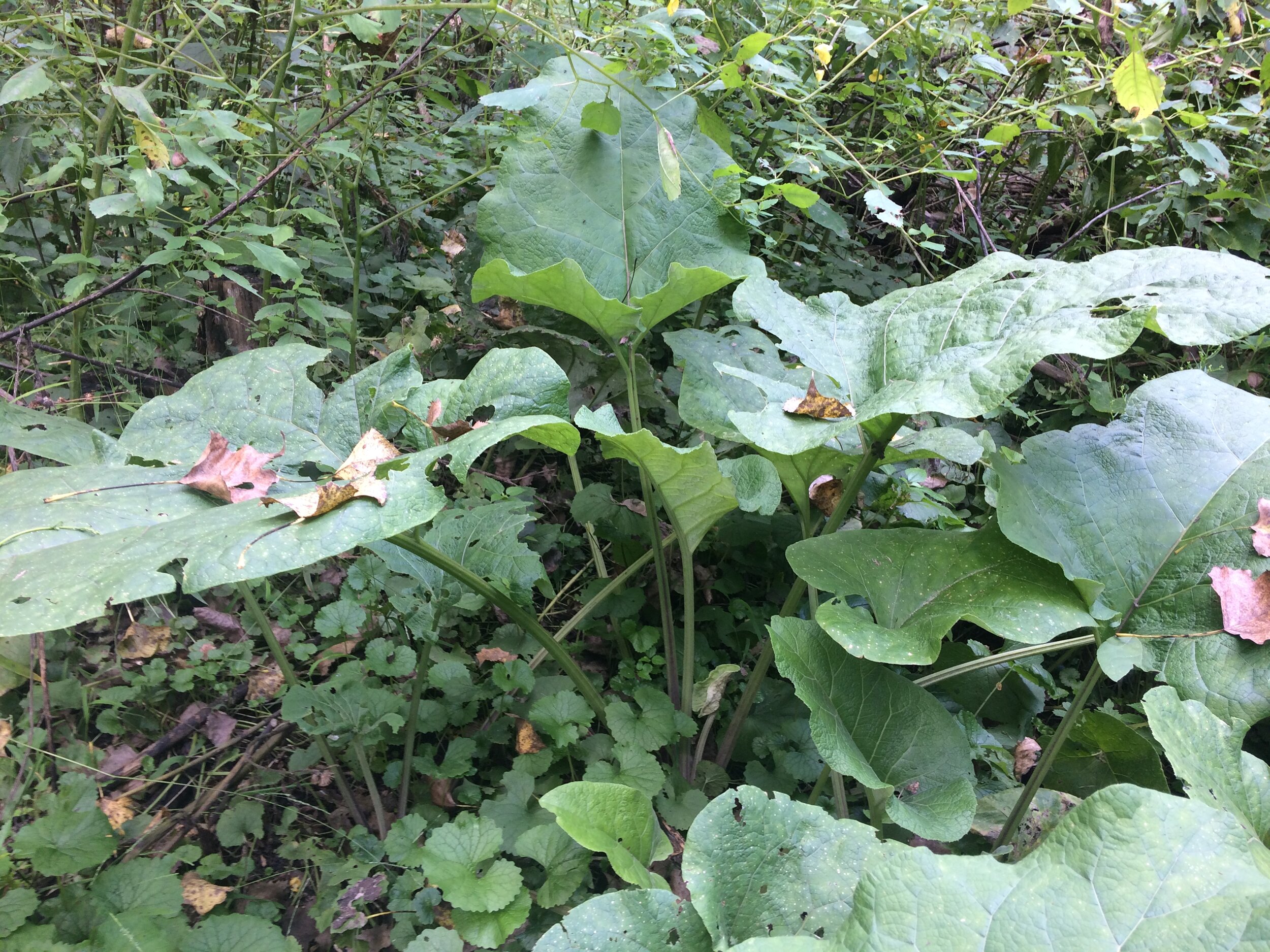
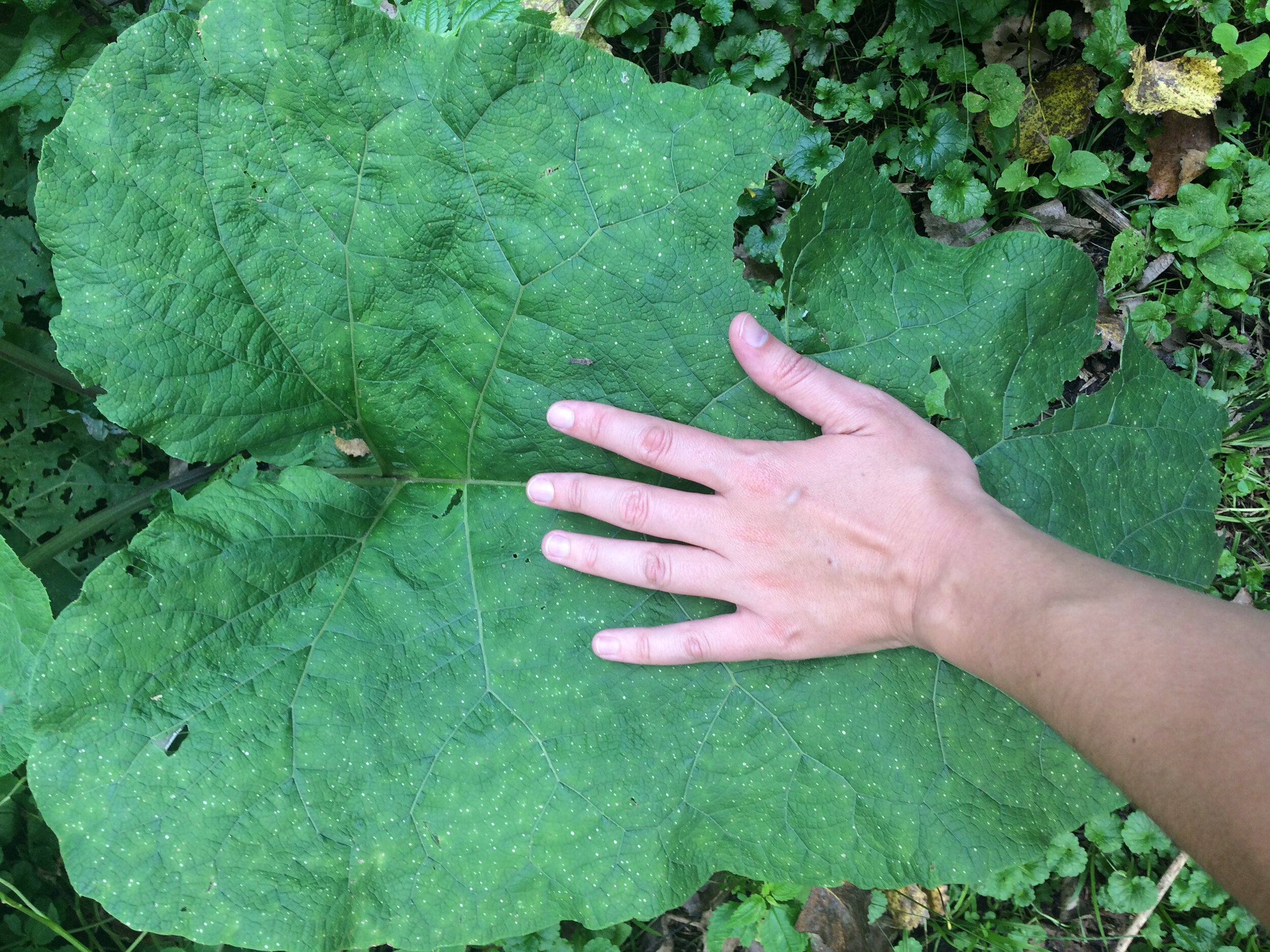
Burdocks are towering plants that can reach five to nine feet in height at maturity. As biennials, they send up a basal rosette of leaves in the first year and typically flower in the second year. Leaves are triangular to egg-shaped, hairy underneath, and basal leaves have wavy edges and heart-shaped bases. The leaves get smaller as they go up the flower stalk, but basal leaves can reach lengths of three to four feet.
Flowers are pink to purplish tufts (technically “disk florets”) emerging from bristly bracts. The flowers become seeds in the fall, encased by the familiar brown burs.
Differentiating Common and Greater Burdock
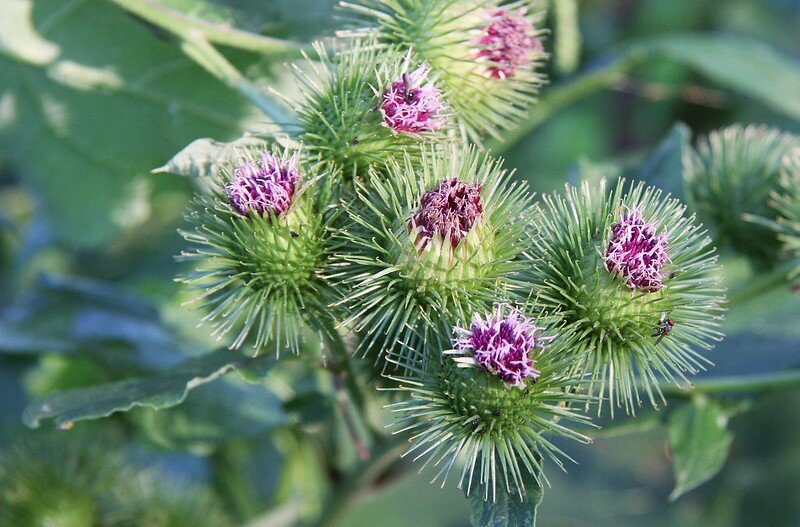
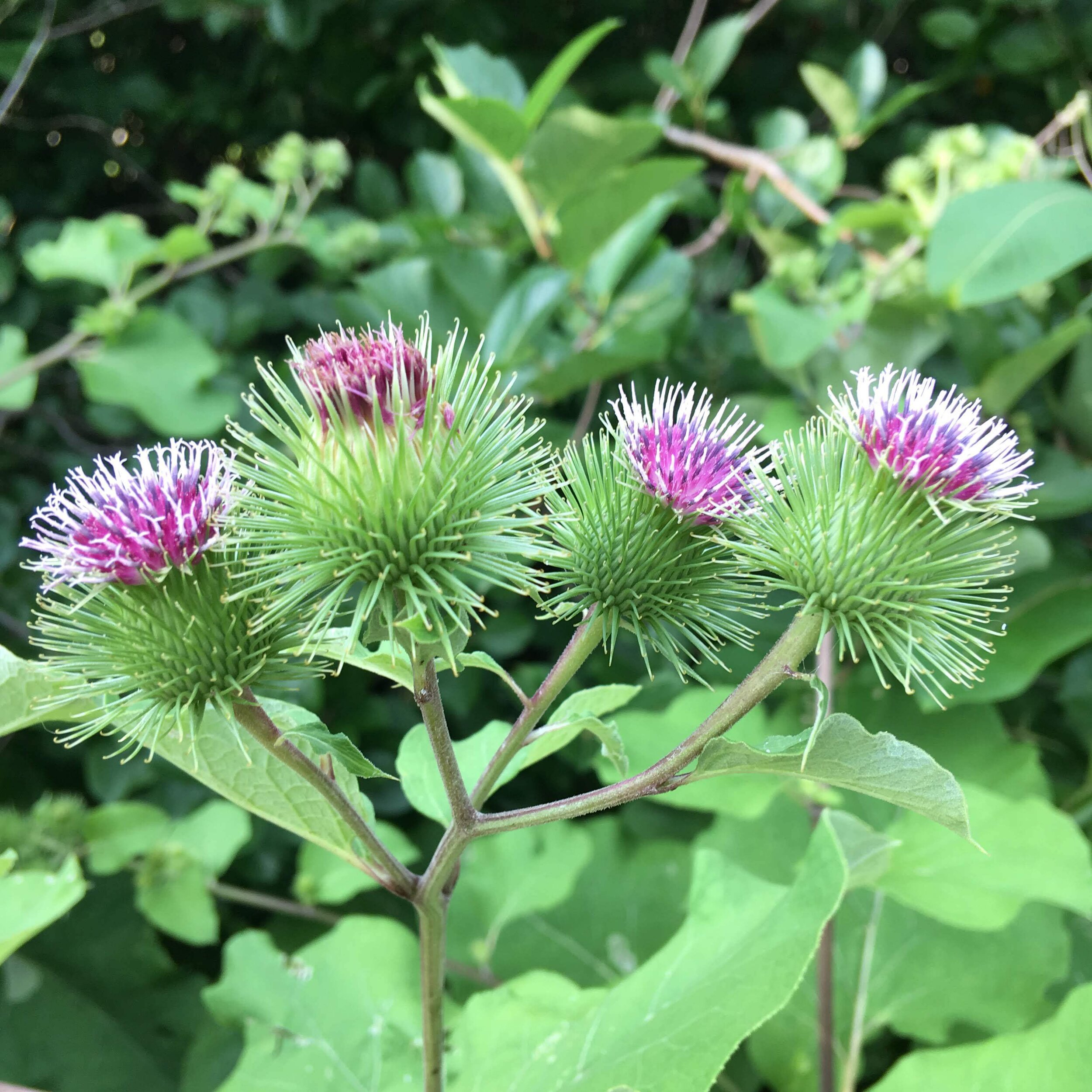
As the name implies, greater burdock is typically taller and has larger leaves than common burdock. However, size varies depending on growing conditions, so this isn’t a reliable way to tell the difference. The lower leaf stems of common burdock are hollow with a slight groove down the middle, while those of greater burdock are solid with a deeper groove, similar to celery. The flower stalk of common burdock has little branching; that of great burdock branches out more. In common burdock, the flowerheads are ½ to 1 inch wide, and are stalkless or on short stalks. Furthermore, due to the oval shape of the flowerhead, the flower petals stick out significantly higher than the green bracts. In greater burdock, the flowerheads are larger, 1 to 1-½ inches wide, and grow on long stalks. The flowerheads are spherical in shape, so the tuft of purple isn’t as noticeable.
Similar Species
Flowerheads of woolly burdock (Arctium tomentosum). Woolly Burdock Flowers / Miroslav Vajdic / CC BY-SA 2.0
There exists a third species of burdock in North America, called woolly burdock (Arctium tomentosum). It can be distinguished by the dense cobwebby hairs on the flowerheads, leaf undersides, and young leaf stems. It ranges from Quebec west to Alberta in Canada, and can be found in the US from Maine to Maryland, Wisconsin to North Dakota, Illinois to South Dakota, and South Carolina, Colorado, and Oregon.
A fourth species of burdock may exist in North America, though apparently there is no consensus on this. It is called woodland burdock (Arctium vulgare or A. nemorosum.) However, it is so similar to common burdock that some consider it a subspecies. It has a limited range in the US: from Maine south to Virginia, and Kansas.
Look Alikes
Many people confuse burdock and rhubarb (Rheum rhabarbarum) because they both have large, triangular leaves. However, the leaf stem of rhubarb is much more red in color. Burdock stems can have reddish streaks, but they’re more maroon in color than bright red. Furthermore, the leaf stems of burdock are grooved, while those of rhubarb are glossy and smooth. Also, the leaf stems of rhubarb are never hollow, whereas those of common burdock are. Finally, the leaves of rhubarb are more curly than those of burdock, and unlike burdock are completely hairless.
Harvest and Preparation
For edible and medicinal purposes, greater burdock is considered the best species, followed by common burdock. There are several edible parts: the leaf stem, flower stalk, and root. Some sources claim the leaves are edible, but in my experience they are consistently bitter beyond belief. I have not found a way to make them palatable, but if you want to try, be my guest! But don’t say I didn’t warn you!
The leaf stem contains only a slight amount of bitterness. When the leaf has reached near full size, it is ready to harvest. Simply cut the stem from the plant, and peel off the outer skin. The inside has a fairly mild taste and a texture that’s crunchy and stringy, similar to celery. It can be eaten raw, or added to stir fries, soups, pot pies, and other hot dishes.
The flower stalk is similar in texture and flavor to the leaf stem, except that it tastes sweeter and has more of a starchy texture. The flavor has been compared to artichokes. Harvest the stalk when it is near its full-grown height; it should be tall and thick, but have no flowers or flower buds. The taller it gets the tougher it gets, so harvesting requires impeccable timing; you want it as tall as possible but still tender. Like the leaf stem it should be peeled, and can be eaten raw or cooked.
The root is perhaps the best-known edible part of burdock. Cultivated in Japan and sold under the name “gobo,” this vegetable can be found for sale in co-ops and specialty stores. To harvest, find a plant in the fall of its first year or the spring of its second year. First year plants display a basal rosette— no flower stalk. If harvesting the root in the second year, it’s important to do so before the plant sends up a flower stalk, or the root will be tough.
Digging burdock root.
Burdock sends a long taproot deep into the soil, which is part of what makes it so infamously hard to eradicate. It can reach several feet in length, and has a tendency to break easily. This can pose challenges to harvesting the root for edible purposes. Basically, the method is to use a shovel or post hole digger to dig a hole alongside the root. Do not attempt to pry the root out of place with the shovel, or it will break and the best part will remain in the ground. Just keep digging parallel to the root until you’ve reached the tip. Then carefully loosen the root out by hand. A trowel may aid in the process. To eat, wash and peel the roots. Cut into matchsticks or slice diagonally into thin ovals. They have a crunchy texture and an earthy, starchy flavor and can be eaten raw or cooked in stir fries!
Medicinal Uses
The primary medicinal uses of burdock come from its bitter principles. These stimulate the digestive tract, including the liver and pancreas. As such, it is a mild laxative and also helps to lower blood sugar. By activating the liver, it helps rid the body of toxins. Burdock also has mild diuretic properties, further promoting the elimination of toxins via urine.
Burdock is also used to treat chronic inflammatory conditions such as rheumatism or arthritis, and skin conditions such as psoriasis and eczema.
Typically the root of burdock is used medicinally, though the leaves and seeds have similar effects. To reap the medicinal benefits, it can be eaten, boiled with water for a tea, or steeped in alcohol for a tincture.
Conclusion
Next time you encounter the distinctive seedheads of burdock, I hope you remember the myriad edible and medicinal uses, and mark the spot for future harvesting. Or at least throw some burs at your unsuspecting friends!
Join Us on Patreon!
This blog post was chosen in a poll by Patreon members. Thank you for your support!
If you like our foraging tutorials, please consider joining us on Patreon! It’s a simple way for you to help Four Season Foraging keep producing the informative content that you enjoy.


